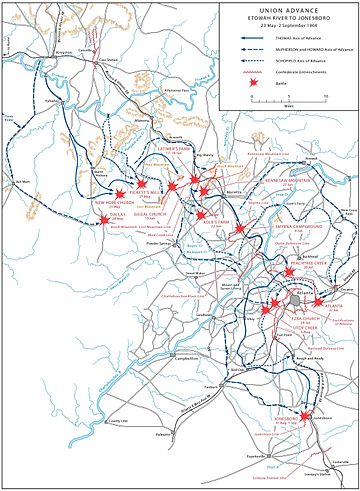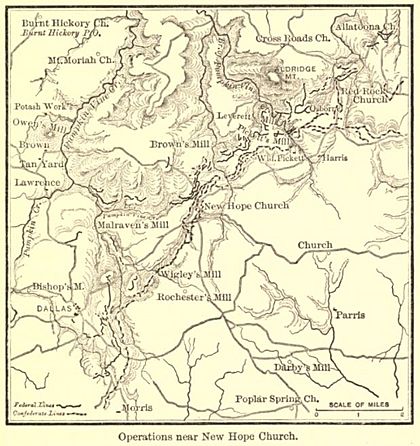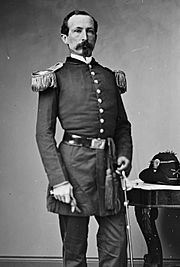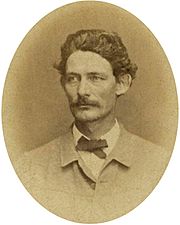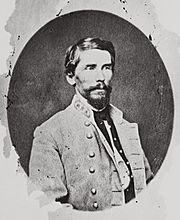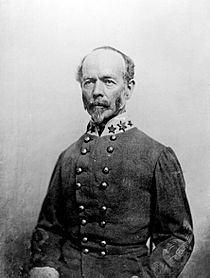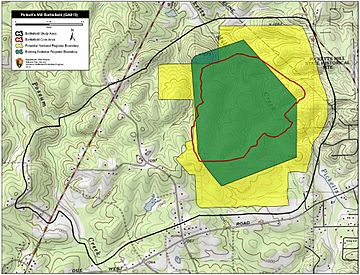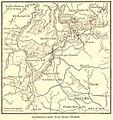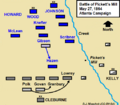Battle of Pickett's Mill facts for kids
Quick facts for kids Battle of Pickett's Mill |
|||||||
|---|---|---|---|---|---|---|---|
| Part of the American Civil War | |||||||
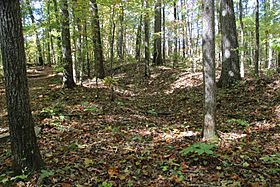 Remains of a trench dug during the battle |
|||||||
|
|||||||
| Belligerents | |||||||
| Commanders and leaders | |||||||
| Joseph E. Johnston Patrick Cleburne John H. Kelly William Y. C. Humes |
William T. Sherman Oliver O. Howard Thomas J. Wood Richard W. Johnson |
||||||
| Units involved | |||||||
| Cleburne's Division Kelly's Division Humes' Division |
3rd Division, IV Corps 1st Division, XIV Corps 3rd Brigade, 3rd Division, XXIII Corps |
||||||
| Strength | |||||||
| Pickett's Mill: 10,000 Campaign: c. 65–75,000 |
Pickett's Mill: 14,000 Campaign: c. 100,000 |
||||||
| Casualties and losses | |||||||
| 500 | 1,600 | ||||||
The Battle of Pickett's Mill happened on May 27, 1864. It was fought in Paulding County, Georgia. This battle was part of the American Civil War. Union soldiers, led by William Tecumseh Sherman, fought against Confederate soldiers. The Confederate forces were led by Joseph E. Johnston.
General Sherman tried to go around Johnston's right side. But the Union troops met strong Confederate resistance. They were pushed back and lost many soldiers. A writer named Ambrose Bierce saw the battle. He later wrote about it in a story called The Crime at Pickett's Mill. This battle was a Confederate victory.
Earlier in May 1864, Sherman's army had forced the Confederate Army of Tennessee to move back. They took a strong defensive spot at Allatoona Pass. Sherman did not want to attack Johnston's lines head-on. So, he tried to move widely around the Confederate western side. Johnston quickly moved his army to block this plan. Sherman's first attack on Johnston's defenses was stopped at New Hope Church. Both armies then dug into their positions. The day after the Union loss at Pickett's Mill, the Confederates attacked the Union right side. This attack was stopped at Dallas. The two armies stayed in their positions near New Hope Church and Dallas. Then Sherman moved his left side closer to the railroad. This forced Johnston to move back to a new spot on June 4.
Contents
Understanding the Battle
Who Fought: Union Army
In the Atlanta Campaign, General William T. Sherman led a large Union force. This force was made up of three armies. They were the Army of the Cumberland, the Army of the Tennessee, and the Army of the Ohio.
The Army of the Cumberland had about 73,000 soldiers. It was led by Major General George Henry Thomas. The Army of the Tennessee had about 24,500 soldiers. It was led by Major General James B. McPherson. The Army of the Ohio had about 13,500 soldiers. It was led by Major General John Schofield. Sherman's total force was very large. It also included many people who helped, like railroad workers and medical staff.
Who Fought: Confederate Army
General Joseph E. Johnston led the Confederate Army of Tennessee. This army had two main groups of infantry. They were led by Lieutenant Generals William J. Hardee and John Bell Hood. There was also a cavalry group led by Major General Joseph Wheeler.
Johnston's army soon got more soldiers. These came from Lieutenant General Leonidas Polk's group. On April 30, 1864, Johnston's army had over 41,000 infantry soldiers. They also had thousands of cavalry and artillery soldiers. Over time, Johnston received more reinforcements. These included several thousand more soldiers.
How the Armies Moved
The Atlanta Campaign started with the Battle of Rocky Face Ridge. This was from May 5–9, 1864. Sherman sent some troops to go around Johnston's defenses. Other troops attacked from the front. Johnston was outflanked, meaning his side was exposed. So, he had to retreat. Then they fought the Battle of Resaca from May 13–16. More Confederate troops arrived during this time.
Johnston kept moving back as Sherman tried to get around his side. Union troops captured Rome. At the Battle of Cassville on May 19, Johnston planned to attack Sherman's spread-out army. But his timing was off. Johnston then took a defensive spot south of Cassville. His generals thought this spot was weak. So, Johnston moved back to Allatoona Pass that night.
Sherman found Johnston's new spot too strong to attack directly. So, he decided to try another move around Johnston's western side. Sherman paused for three days. Then he sent his right wing south to Van Wert. From there, they moved east toward Dallas. Thomas's army was in the middle. Schofield's corps was on the left.
Sherman ordered his wagons to carry 20 days of food. This was because they were moving away from the railroad. Thomas's army crossed the Etowah River. They marched through Euharlee and Stilesboro. Johnston learned about Sherman's move from his cavalry. On May 23, he ordered his troops to march to Dallas and New Hope Church. By May 25, Johnston's army was in position. Hardee's troops were near Dallas. Hood's troops were at New Hope Church.
Union troops, led by Joseph Hooker's XX Corps, moved forward. They met Confederate resistance at Pumpkinvine Creek. Brigadier General John W. Geary's division pushed ahead. They met Hood's troops at New Hope Church. This was at 5 pm. In the Battle of New Hope Church on May 25, Hooker's divisions attacked Hood's position many times. But they could not succeed. The battle lasted three hours. Hooker's troops lost about 1,665 soldiers. The Union soldiers called this place the "Hell Hole."
By May 26, both sides had dug trenches. There was constant fighting between the two armies. McPherson's two corps took Dallas. They faced Hardee's corps about 2 miles (3.2 km) east. Schofield's XXIII Corps also arrived. They marched all night in the rain. Schofield was hurt when his horse fell. So, Jacob Dolson Cox took temporary command. Sherman directed Schofield's corps to the left of Howard's corps. They came into line near Brown's saw-mill.
The Battle of Pickett's Mill
Sherman's Plan
Sherman decided to go around Johnston's right side. He knew his army had more soldiers. Both armies were dug in. Sherman thought he could gather some troops. He would use them to get around the Confederate defenses. Also, by moving his left side north, Sherman could get closer to the railroad. On May 26, Union cavalry beat Confederate cavalry. This seemed to show that Johnston's right side was only protected by cavalry.
On May 27, Union cannons fired at Confederate defenses. The Confederate cannons fired back. Sherman wanted Oliver Otis Howard's troops to attack what he thought was Johnston's right side. Schofield's troops would support them. Howard moved Thomas J. Wood's division from its trenches. He replaced them with another division. As Wood's division marched north, Howard and Thomas checked the attack spot. They saw the attack would cross an open field. This field was open to Confederate fire. So, Thomas told Howard to move the attack farther north. This was to the left of Schofield's lines. Thomas also sent Richard W. Johnson's division to help Wood's attack.
At 11 am, Wood's division formed into a column. Each group of soldiers was in two lines. So, the division had six lines, one behind the other. Johnson's division formed in a similar way. The Union divisions marched through very thick forests. Wood gave his leading officer a compass to guide them. After marching about 1.5 miles (2.4 km), Howard ordered them to turn right. They were to get ready to attack.
Wood's scouts went forward. They found Confederates digging trenches. But the trenches did not go all the way to the left. Howard decided to attack farther north. He ordered Nathaniel McLean's brigade to support Wood's right side. McLean's group was from the XXIII Corps.
Earlier, Johnston had moved Patrick Cleburne's division to his far right side. Cleburne's division was dug in. Their scouts saw Howard's movement. Johnston thought Sherman was retreating. He ordered his troops to check the Union lines. They found that Sherman's defenses were strong. With this, Johnston realized Sherman was trying to go around his right side. He moved his troops to help Cleburne. Sherman then understood that Johnston had blocked his plan. Sherman quickly changed his strategy. He decided to move northeast toward the railroad.
The Attack Begins
After marching another 1 mile (1.6 km), Wood's and Johnson's troops reached Pickett's Mill Creek. Howard and Wood checked the area again. They saw Confederates digging trenches. But the trenches did not go all the way to the left. Howard ordered Wood and Johnson to swing their divisions to the right. He told McLean to make a fake attack. This was to draw fire away from Wood's real attack. Wood quickly got his division ready to attack. But Johnson and McLean moved their groups very slowly.
At 4:30 pm, Wood ordered William Babcock Hazen's brigade to go forward. Hazen's brigade was in front. Wood said to Howard, "We will put in Hazen, and see what success he has." Howard agreed. Hazen thought Wood's whole division would attack. But he realized his 1,500-man brigade was going to attack alone. Hazen looked at his staff officer, Ambrose Bierce. Bierce knew a "criminal blunder" was about to happen. All officers sent their horses away and went forward on foot. Hazen guided his brigade with a compass. The woods were very thick. Hazen's men soon met about 1,000 Confederate cavalrymen. These were from John H. Kelly's and William Y. C. Humes's divisions.
The Confederate cavalry fought back bravely. But they were spread out. Hazen's infantry forced them to move back. Hazen's troops reached a ravine. They saw a ridge ahead, about 100 yards (91 m) away. As Hazen's soldiers rushed to take the ridge, Hiram B. Granbury's Texas brigade arrived first. Cleburne had sent Granbury's brigade to help the cavalry. The Texans took cover. They fired at the Union troops. Many Union soldiers were hit. Some of Hazen's men got within 20 to 30 yards (18 to 27 m) of Granbury's line. Then they had to take cover and fire back.
Hazen's soldiers were losing many men. They were also running low on bullets. Hazen sent urgent messages asking for help. But no help came. Neither Wood nor Howard ever explained why. After 50 minutes, the Union survivors pulled back on their own. Hazen did not try to stop them.
Finally, with Hazen's attack over, Wood ordered William Harvey Gibson's brigade forward. He thought "a second effort might be more successful." Gibson's men were stopped by the same heavy rifle and cannon fire. Johnson's division finally showed up on Gibson's left. But they were quickly pinned down by fire from Kelly's cavalry. On Gibson's right, McLean's troops did nothing. So, Confederate cannons fired at Gibson's soldiers.
After an hour of trying to take the ridge, Gibson's troops pulled back. They joined Hazen's men in the back. The soldiers complained that they had been "sold out." At 6 pm, Howard got a message. Sherman had canceled the attack at 5:15 pm. He ordered Howard to only defend. Howard told Wood to send Frederick Knefler's brigade forward. They were to hold the Confederates until trenches were dug. Knefler's brigade advanced at 6:30 pm. They stumbled into the ravine. There, they were hit by heavy fire. Knefler's men pulled back. They took a position where they fired at the Confederates until night.
After dark, Knefler's men went forward. They tried to get as many wounded Union soldiers from the ravine as they could. At 10 pm, Knefler got the order to pull back. The defense line was finished. At the same time, Granbury ordered his men to charge into the ravine. They were to drive off any remaining Union soldiers. In the dark, few soldiers were hit by bullets. But Granbury's Texans captured many Union soldiers. They chased others away. Then Granbury's troops went back to the ridge. That night, a Texas soldier on guard duty in the ravine was sickened by what he saw. He noted that many Union soldiers were shot in the head.
What Happened Next
Cleburne's division reported about 448 soldiers hurt. Most of these were from Granbury's brigade. The Union soldiers lost about 1,600 killed, wounded, and missing. The American Battlefield Trust estimates 500 Confederate losses and 1,600 Union losses. In this battle, many Union soldiers were killed. This was unusual. One dead body was found with 47 bullet holes. Hazen's brigade lost 467 soldiers. Gibson's brigade lost 681. Knefler's brigade lost 250, mostly prisoners. About 70 wounded and 140 unwounded Union soldiers were captured.
Historians say that Wood's troops were attacked from the front by Cleburne's division. They were also attacked on their right by Hindman's division. Cavalry attacked them on their left. Even so, some believe the attack might have worked if Johnson had pushed straight on. But the Union attack was not well-coordinated.
Sherman then decided to fully commit to moving his army to the left. This was toward the railroad. His soldiers were not getting enough food. Even though the wagons carried 20 days of food, it was hard to get it to the soldiers. The roads were bad, and it was 20 miles (32 km) to the Union base at Kingston.
Hood's corps marched all night on May 27–28. They planned to attack Sherman's new left side. But at 6 am on May 28, scouts reported that Union soldiers were behind strong defenses. So, Johnston called off the attack. That day, Johnston ordered Hardee to check McPherson's lines. He wanted to see if Union troops were still there. At 3:45 pm, a Confederate attack on John A. Logan's XV Corps began. This attack, part of the Battle of Dallas, went badly. Over 1,000 Confederates were shot. Logan reported only 379 Union losses.
Sherman's move to the left finally began. On June 1, Union cavalry took Allatoona. This allowed Sherman's railroad crews to fix the tracks. On June 2, Schofield's XXIII Corps moved forward. They met Confederate trenches near Allatoona Creek. On June 3, Union cavalry took Acworth on the railroad. On the same day, Hooker's XX Corps extended Sherman's left side even further. On the night of June 4–5, Johnston left his defenses near New Hope Church. He moved to a new line. The next big fight was at the Battle of Gilgal Church on June 15.
Between May 23 and June 6, Sherman's forces lost about 4,500 soldiers. Johnston's army lost about 3,000. Confederate morale improved after Johnston's defensive wins. Since the campaign started, Sherman's armies had lost about 12,000 soldiers. Johnston's army had lost about 9,000.
Ambrose Bierce, a famous writer, fought for the Union at Pickett's Mill. He was a mapmaker. His short story The Crime at Pickett's Mill is his personal account of this battle.
Visiting the Battlefield Today
The Pickett's Mill Battlefield Site is now a Georgia state park. It is located at 4432 Mount Tabor Church Road, Dallas, Georgia 30157. The park is very well preserved. You can visit a center there to learn more. You can also see the old earthworks, which are trenches dug by the soldiers. There is also an old pioneer cabin and hiking trails.
Images for kids


